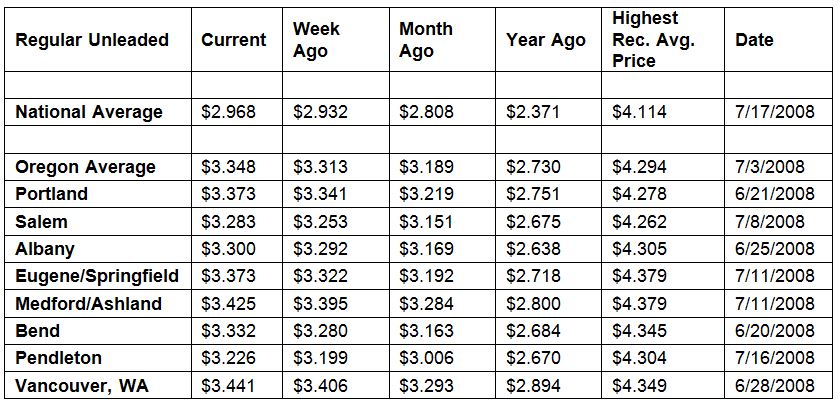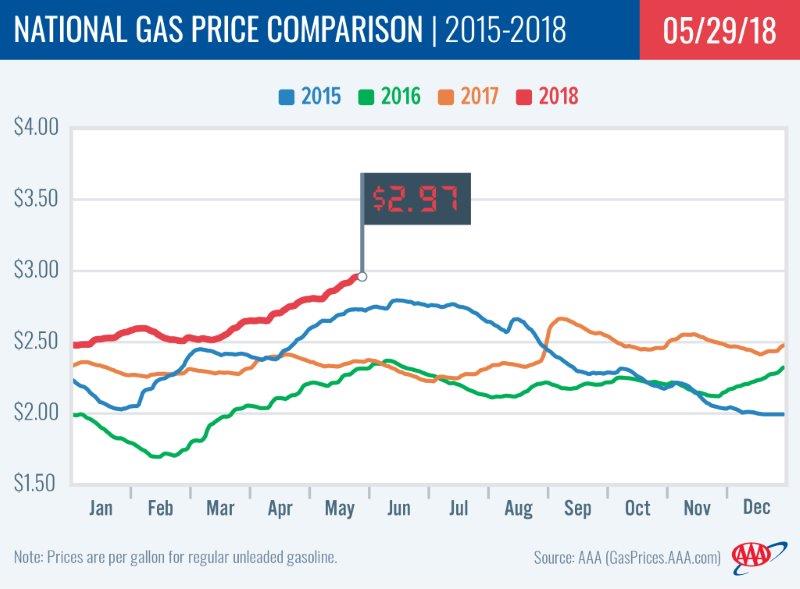PORTLAND, Ore., – Just as the Memorial Day holiday weekend was beginning, reports indicated that OPEC may raise oil production levels to help ease global supply concerns. The news sent crude oil prices plunging, while gas prices held fairly steady over the weekend. For the week, the national average for regular adds four cents to $2.97 a gallon, its highest price since November 2014. The Oregon average also climbs four cents to $3.35, its highest price since October 2014. This week, three more states join the list of states with a gas price average at or above $3 a gallon, making for 17 states in total.
The price of crude oil has dropped nearly $3 per barrel since last Thursday. “If oil prices remain lower, drivers will get some welcome relief,” says Marie Dodds, public affairs director for AAA Oregon/Idaho. “The national average has risen 16 cents a gallon since May 1 and the Oregon average has increased 15 cents during that time. Pump prices have been at their highest levels for this time of year since 2014.”
Oregon is one of 48 states and the District of Columbia reporting week-over-week increases. The largest jumps are in Michigan (+10 cents) and Illinois (+7 cents). Oregon has the 24th-largest weekly increase in the country at four cents. Indiana (-2 cents) and Utah (-2/10ths of a cent) are the only states to see prices fall this week.
All 50 states and the District of Columbia have higher prices than one month ago. The national average and Oregon average are both 16 cents more than a month ago. Oregon has the 34th-largest monthly increase in the country. Wisconsin (+27 cents) and Colorado (+26 cents) have the largest monthly gains.
The West Coast still has the most expensive gas prices in the nation. California tops the list again for the fifth week in a row, followed by Hawaii, Washington, Alaska, Oregon and Nevada. Oregon is fifth most expensive after spending six weeks at sixth.
| Rank | Region | Price on 5/29/18 | |
| 1 | California | $3.74 | |
| 2 | Hawaii | $3.71 | |
| 3 | Washington | $3.46 | |
| 4 | Alaska | $3.40 | |
| 5 | Oregon | $3.35 | |
| 6 | Nevada | $3.33 | |
| 7 | Idaho | $3.18 | |
| 8 | Connecticut | $3.15 | |
| 9 | Utah | $3.15 | |
| 10 | Pennsylvania | $3.12 |
According to the U.S. Energy Information Administration’s (EIA) report for the week ending on May 18, inventories of gasoline on the West Coast climbed by 500,000 bbl to 30.2 million bbl. When compared to a year ago, levels are up over 1 million bbl.
The nation’s cheapest markets are South Carolina ($2.65) and Mississippi ($2.66). For the 43rd week in a row, no states have an average below $2.
Drivers in all 50 states and the District of Columbia are paying are paying more than a year ago to fill up. The national average is 60 cents more and the Oregon average is 62 cents more than a year ago. This is the 11tht-largest yearly increase in the country. Arizona has the greatest year-over-year increase of 75 cents; Indiana is second at 73 cents; and New Mexico is third at 67 cents.
Oil Market Dynamics
Just last week, crude oil prices jumped to around $73 per barrel, their highest prices in three and a half years. This week, prices are down nearly 10 percent. Oil prices plunged on Friday following reports that OPEC may increase output by about 1 million b/d ahead of schedule in order to ease continued crude price growth as economic turmoil in Venezuela and renewed U.S. imposed sanctions on Iran could further reduce global supply. Energy ministers from Russia, Saudi Arabia and the United Arab Emirates met in St. Petersburg, Russia, last week to review the status of their global oil supply reduction agreement, which has helped to decrease global oil supplies and raise prices since the beginning of 2017. The pact is scheduled to dissolve at the end of 2018. If OPEC and its partners announce a supply increase, it will likely occur at the next OPEC meeting on June 22 in Vienna, Austria.
Oil prices also declined after EIA’s weekly report showed that total crude inventories grew by 5.7 million bbl. A decrease in crude exports, an increase in imports and record-breaking crude production contributed to the inventory growth. The news was a surprise to the market, which expected to see inventories decline in the run-up to Memorial Day weekend. If the trend continues in the weeks to come, crude prices may continue to edge lower. At 438.1 million bbl, stocks are 78.2 million bbl lower than they were at this time last year.
Additionally, Baker Hughes, Inc. reported that the U.S. added 15 oil rigs last week, bringing the total to 859, the highest level for the year so far. The total is up by 137 rigs when compared to last year at this time.
At the close of Friday’s formal trading session on the NYMEX, WTI fell $2.83 cents to settle at $67.88. Markets were closed yesterday in observance of Memorial Day. Today crude is trading around $67, compared to $72 a week ago. Crude prices are down about three percent in the last month and are about $19 more per barrel than a year ago.
Drivers can find current gas prices along their route with the free AAA Mobile app for iPhone, iPad and Android. The app can also be used to map a route, find discounts, book a hotel and access AAA roadside assistance. Learn more at AAA.com/mobile.
Diesel
For the week, the national average rises two cents to $3.21 a gallon. Oregon’s average adds three cents to $3.41. A year ago the national average for diesel was $2.51 and the Oregon average was $2.70.
Find current fuel prices at GasPrices.AAA.com.
AAA news releases, high resolution images, broadcast-quality video, fact sheets and podcasts are available on the AAA NewsRoom at NewsRoom.AAA.com.



